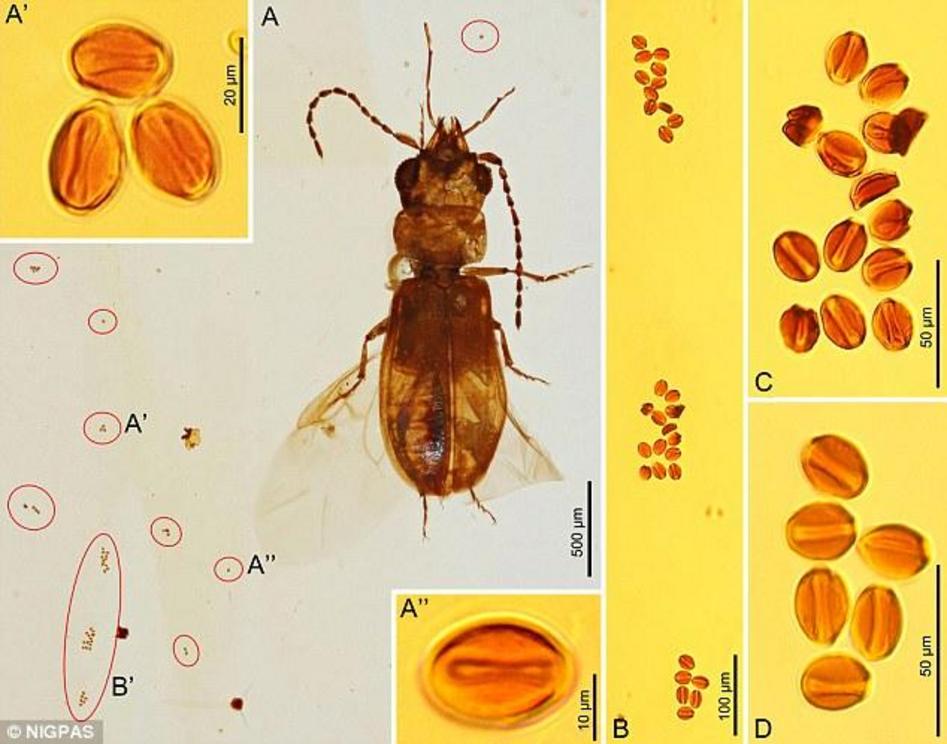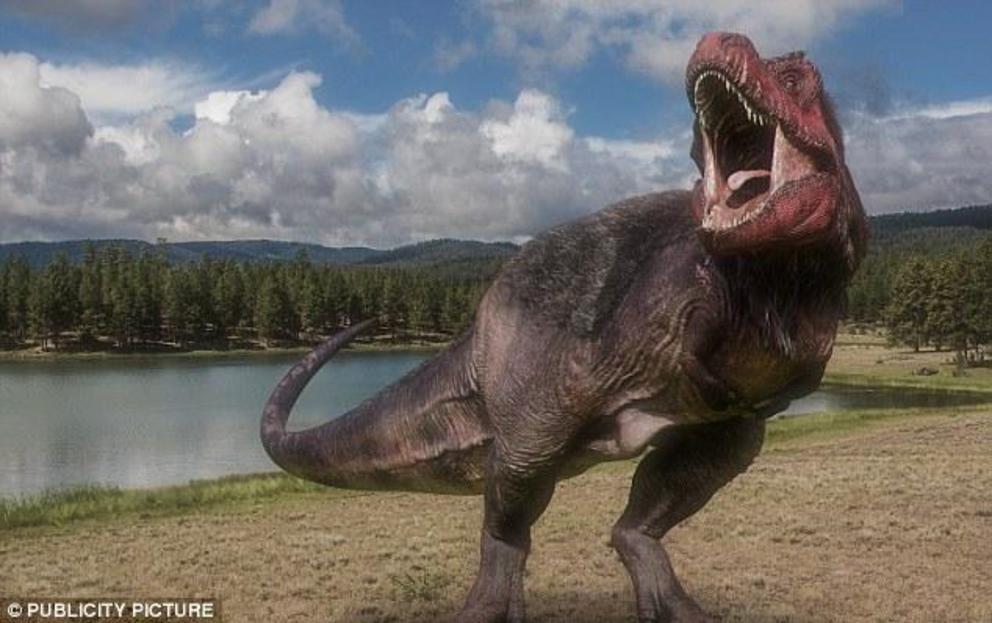Remains of a 99-million-year-old beetle that crawled alongside T-Rex have been found encased in amber
- The beetle is believed to be the world's earliest insect pollinator
- Its body was coated with pollen grains when it became encased in tree resin
- The creature would have been crawling over plants for nourishment
The preserved remains of a 99-million-year-old beetle that crawled alongside T-Rex have been found encased in amber.
The beetle is believed to be the world's earliest insect pollinator and its body was coated with pollen grains when it became encased in the clear tree resin.
It would have been crawling over plants for nourishment when it was frozen in time during the Cretaceous period.
The amber has preserved it in astonishing detail and even especially adapted cavities in its jaws are visible.
 Amazingly preserved remains of a 99-million-year-old beetle that crawled alongside T-Rex has been found in amber (pictured). The beetle is believed to be the world's earliest insect pollinator and its body was coated with pollen grains
Amazingly preserved remains of a 99-million-year-old beetle that crawled alongside T-Rex has been found in amber (pictured). The beetle is believed to be the world's earliest insect pollinator and its body was coated with pollen grains
'It is remarkable several aggregations of exquisitely preserved pollen grains are located along the left side of the fossil beetle and with two pollen grains close to the head', said Dr Chenyang Cai, a research fellow at the University of Bristol.
Named Cretoparacucujus cycadopholis – or 'lover of cycads' – it had an unusually large head, big eyes, sharp claws and huge antennae.
It belongs to a family of beetles known as boganiids and had been pollinating the world's oldest seed plants, called cycads.
These primitive evergreens resemble palms and have been around for 300 million years but are now among the most threatened on Earth.
'Boganiid beetles have been ancient pollinators for cycads since the age of cycads and dinosaurs', said Dr Cai.
The finding suggests they could have been pollinating plants for 200 million years – much longer than previously thought.
Dr Cai said: 'Our find indicates a probable ancient origin of beetle pollination of cycads at least in the Early Jurassic, long before angiosperm dominance and the radiation of flowering-plant pollinators, such as bees, later in the Cretaceous.'
Beetles were among the first insects to visit flowers, tens of millions of years before bees or butterflies appeared.
They remain essential pollinators today, especially for ancient species such as magnolias and spicebush.
 The creepy crawly belongs to a family of beetles known as boganiids and had been pollinating the world's oldest seed plants, called cycads
The creepy crawly belongs to a family of beetles known as boganiids and had been pollinating the world's oldest seed plants, called cycads
WHAT IS THE 'LOVER OF CYCADS' BEETLE?
The amazingly preserved remains of a 99-million-year-old 'lover of cycads' beetle that crawled alongside T-Rex has been found in amber.
Named Cretoparacucujus cycadopholis – or 'lover of cycads' – it had an unusually large head, big eyes, sharp claws and huge antennae.
It belongs to a family of beetles known as boganiids and had been pollinating the world's oldest seed plants, called cycads.
These primitive evergreens resemble palms and have been around for 300 million years but are now among the most threatened on Earth.
The beetle is believed to be the world's earliest insect pollinator and its body was coated with pollen grains when it became encased in the clear tree resin.
It would have been crawling over plants for nourishment when it was frozen in time during the Cretaceous period.
The amber has preserved it in astonishing detail and even especially adapted cavities in its jaws are visible.
The most impressive feature of Cretoparacucujus is its big head.
It had a powerful lower jaw that jutted out, massive compound eyes, sharp claws and extremely long antennae.
The beetle was unearthed at a fossil site in the town of Tanai in northern Myanmar which has become a treasure trove of prehistoric insects and vertebrates during the past 20 years.
Flowering plants, or angiosperms, are well known for their special relationship with insects and other pollinating animals.
But cycads are gymnosperms that have no flowers or fruits and were on the scene long before.
They may have been the first insect-pollinated plants, according to the research published in Current Biology.
The most impressive feature of Cretoparacucujus is its big head.
It had a powerful lower jaw that jutted out, massive compound eyes, sharp claws and extremely long antennae.
The beetle was unearthed at a fossil site in the town of Tanai in northern Myanmar which has become a treasure trove of prehistoric insects and vertebrates during the past 20 years.
Added Dr Cai: 'Our discovery indicates a probable ancient origin of beetle pollination of cycads at least in the Early Jurassic, long before angiosperm dominance and the radiation of flowering-plant pollinators later in the Cretaceous.'
The Early Jurassic is a geological period that spans from 201.3 to 174.1 million years ago.
 It would have been crawling over plants for nourishment when it was frozen in time during the Cretaceous period when T-Rex (pictured) was around
It would have been crawling over plants for nourishment when it was frozen in time during the Cretaceous period when T-Rex (pictured) was around
WHAT IS AMBER?
Amber has been used in jewelry for thousands of years, and is often found to hold remarkably well-preserved materials from eras long since passed.
The golden-coloured translucent substance is formed when resin from extinct coniferous trees became hardened and then fossilised.
Often insects, plant material, pollen and other creatures became trapped in the resin, causing them to be entombed within after it solidified.
The fossil was found by Dr Cai's supervisor Professor Diying Huang at the Chinese Academy of Sciences at Nanjing.
When Dr Cai first saw the fossil he was immediately intrigued and recognised its bristly cavities might suggest the beetle was a pollinator of cycads.
After cutting, trimming, and polishing the specimen to get a better look under a microscope, his excitement only grew as he saw that the beetle even carried clumps of pollen grains.
He also conducted an extensive DNA analysis to explore the beetle's family tree and found the fossilised beetle belonged to a sister group to the Australian Paracucujus, which pollinates the relic cycad Macrozamia riedlei today.
Dr Cai believes similar beetle pollinators of cycads are yet to be found.
Cycads today they face a risk of extinction four times greater than the average for plants.
One of the worst threats comes from the trade in wild plants for the horticultural trade.
